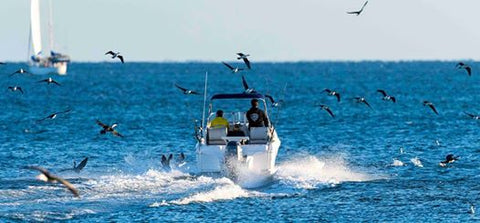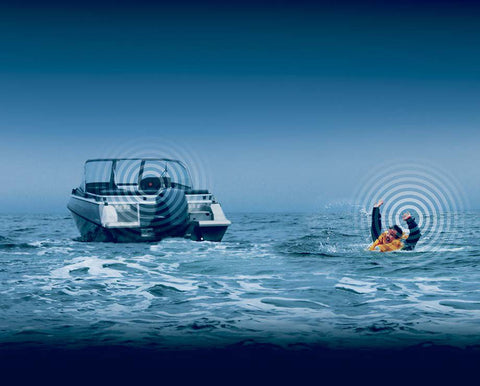Boat Fishing
Don't forget these tips when boat fishing
Fishing from the boat is an extremely popular way for fishers to enjoy Western Australia's coastline and all it has to offer. Before you hit the water, ensure you know everything you need to know about safety equipment, including what you must have on board, how to use it, how to stow it and how to keep it maintained.
Know the conditions
Make sure you are aware of the local weather, swell and tidal conditions before going fishing. Once at a fishing location take some time to observe the current conditions, they may be different to those predicted or may be changing.
For more on conditions, see bom.gov.au
Find out about annual tide predictions at various locations along Western Australia's coast, here.
What safety equipment do I need? (Department of Transport - Marine Safety Checklist)
Wherever you operate your boat you will be required to carry certain items of safety equipment. These include:
- Anchors
- Bailers
- Bilge pumps
- Distress flares
- Electronic position indicating radio beacons (EPIRBs)
- Fire extinguishers
- Life jackets
- Personal locator beacons (PLBs)
- Radios
Make sure you check out Marine Safety's "Step by step guide to maintaining your boat.'' https://www.transport.wa.gov.au/mediaFiles/marine/MAC_P_BESTCheck_MarineSafety.pdf
View the Required Safety Equipment Matrix HERE.
A skipper's responsibility
As skipper, you should make sure that:
- Everyone knows how to use the safety equipment. Have everybody practice putting on life jackets in good conditions so they are familiar with how to put them on and how they feel.
- You are familiar with the instructions for use of distress beacons, inflatable life jackets, distress flares and the firefighting equipment. You may not have time for a crash course in an emergency.

Maintenance & Storage
All safety equipment must be maintained in very good condition and be accessible at all times.
As skipper, you must brief everyone on the vessel about where the equipment is kept. It should be stowed where it is easily reached and preferably visible.
Keep the following points in mind every time you load and stow your equipment aboard:
- Life jackets need to be worn, not locked away in a cupboard or under bunks.
- Distress flares need to be kept dry and accessible (use a waterproof container that will float).
- Distress beacons should be positioned in the cockpit or near the helm where it can be reached quickly in an emergency.
- Download the Recfishwest App (available on iPhone & Android) to log your safety equipment and set reminders for when they are due to expire.
Life jackets
A lifejacket is the most important piece of safety equipment on your boat and is your primary life support device if your boat sinks. If you are not wearing your lifejacket, it cannot save your life.
- Who must carry them?
- Vessels operating in unprotected waters (outside the waters contained by any breakwater or in any lake, river or estuary other than the waters of Cambridge Gulf or Lake Argyle) must carry an approved life jacket for each person on board.
- Each life jacket must suit the weight of the person for whom it is intended, be maintained in good condition and kept in an easily accessible place (preferably worn at all times)

Boat checks
To assist skippers and reduce the number of boating incidents on our waterways DoT has developed the BEST boat check. The BESTcheck should be completed prior to every trip to ensure your Boat, Equipment, Safety equipment and Trailer are all in good order for a day on the water.
- Boat.
- Equipment.
- Safety.
- Trailer.
The BEST check ensures your day is not ruined by an oversight, it's a quick activity to give peace of mind.
A well-serviced boat should not let you down. The recommended annual 45 point check will help skippers identify issues before they become a problem but it all starts with having a regular service. Take the time to have your boat serviced at least once a year.
The BEST and 45 point annual checks lists will not cover all types of boats and voyages but there's no doubt they can help make your next voyage less stressful and possibly much more enjoyable.
for more information on BESTcheck, click here.

Australian Launch - MOB+ by Fell Marine – Wireless Kill Cord Safety Lanyard
Author: Jeff Bullock – RIB Rescue
It is quite well acknowledged that safety systems and products are only ever any good if they are being worn or used appropriately and even then some systems are not fail-safe. The biggest reasons for safety product or process failure is a lack of practicality, function or an adverse impact on the intended activity. The safety lanyard on outboards is no different and you see more dangling from the console than dangling from the skipper.
A Norwegian company named Fell Marine have arguably conquered one of the great holy grails of boating safety when they developed the completely wireless kill switch device called the MOB+ (Man Over Board Plus).

Figure 1 Photo Credit Tony Tropiano
The MOB+ is a hub unit installed in the console of any boat that talks to a separate arm band on the skipper. The unit uses some of the world’s most complex wireless frequency technology to stay in contact and then to immediately and automatically shut down the engine in the event of being submersed in water, moving more than a 20m from the console or during manual activation of the arm band or hub unit.

Getting boat owners to wear the kill cord is still a huge hurdle and somewhat insurmountable because it does get tangled easily in clothing and controls and you can’t move from the console at all. This really does make it hard when you need to move around the boat most often like, fishing, skiing and tying up mooring ropes etc. MOB+ is about combining the safety of a kill cord with the convenience and freedom of wireless technology.

Figure 2 Photo Credit Felt Marine
Each boat has an MOB+ hub unit installed in the console and then the wearable rubber Xband is paired to that device. Once paired for the first time, activation is a simple push button when you jump on board. You can pair your xband to more than one vessel making it a versatile product for clubs and organisations which use a number of support boats. You can watch the video to see how it works here: https://youtu.be/C9cY0hxcHnk
Australia has quite specific testing and approval process for this sort of technology so only units approved for sale in Australia can be sold and installed here. For product enquiries please contact RIB Rescue on 08 9244 9515 or visit http://www.ribrescue.com.au/ .
Shark sightings
- Sharks: Before you go fishing, check out the SharkSmartWA app or Sharksmart website to stay up to date with current alerts, warnings and the latest reported sightings. The app and website provides beach users with near ‘real time’ information on shark activity, including current alerts and warnings issued by the Department of Primary Industries and Regional Development, as well as access to Surf Life Saving WA’s beach safety information. Remember the map shows available information – not all sharks are tagged, or sightings reported, so be Sharksmart when using the water.
- Please report all shark sightings directly to the Water Police on 9442 8600. This number is staffed 24 hours, seven days a week and will activate any required response.



